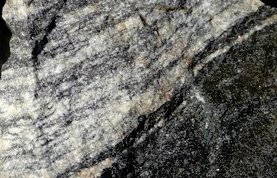
|
The oldest known rocks on Earth are in the Acasta Gneiss Complex in Northern Canada. (The formation is known as Idiwhaa gneisses because 'Idiwhaa' means 'ancient' in the language of the local Tlicho tribe.) These are felsic rocks recovered from the Acasta River, and according to uranium-lead dating of the zircon crystals lodged inside them, they are 4.02 billion years old. (The Earth itself is around 4.55 billion years old.) |
|
|
Felsic rocks are igneous rocks rich in feldspar and silicon. (The word 'felsic' is made up by combining parts of the names of those two minerals.) Because they are made of lighter elements, felsics tend to be more buoyant than mafic rocks like basalt, which are high in magnesium and iron. It is generally believed that the Earth's early crust was predominantly silica-poor mafic rocks. The interesting thing about the felsic rocks found in Acasta river is that their chemical composition is somewhat different from the common felsic rocks found in other places. Idiwhaa Gneiss has high Fe but low Mg content. And there is the still-unanswered question of how felsic rocks could form from the silica-poor mafic rocks in the Acasta River. By analysing the chemical composition and melting points of different components of the Acasta River felsic rocks, the authors of a recent study (ref) concluded that that these rocks originate from the melting of pre-existing iron-rich basalts which formed the uppermost crust of the primitive Earth. The lead author, Tim Johnson from Curtin University in Perth, explained that the team of geologists used trace element modelling to show that the Acasta River rocks were produced by partial melting of the original mafic rocks at very low pressures. "It would have needed something special to produce the 900°C temperatures needed to generate these early felsic rocks at such low pressures." Tim Johnson said. The researchers concluded that the heat required for partial melting at such shallow levels is most easily explained through meteorite impact. "We estimate", said Tim Johnson, "that rocks within the uppermost 3km of mafic crust would have been melted in producing the rocks we see today. We think that these ancient felsic rocks would have been very common, but the passage of 4 billion years, and the development of plate tectonics means that almost nothing remains." So, although now unique, the felsic rocks of the type found in the Acasta Gneiss Complex were probably common on the early Earth. Also, given the estimated high rate of meteorite strikes at that time, impact melting may have been the predominant mechanism that generated Hadean felsic rocks. Journal Reference: | |
| _______________________________ | ||||
| Home | | | Shopping | | | Database |
© Biscuit Software 2004-2018
All rights reserved